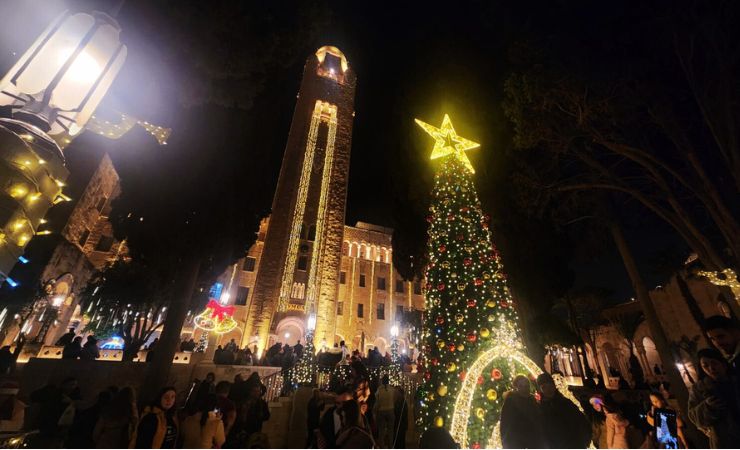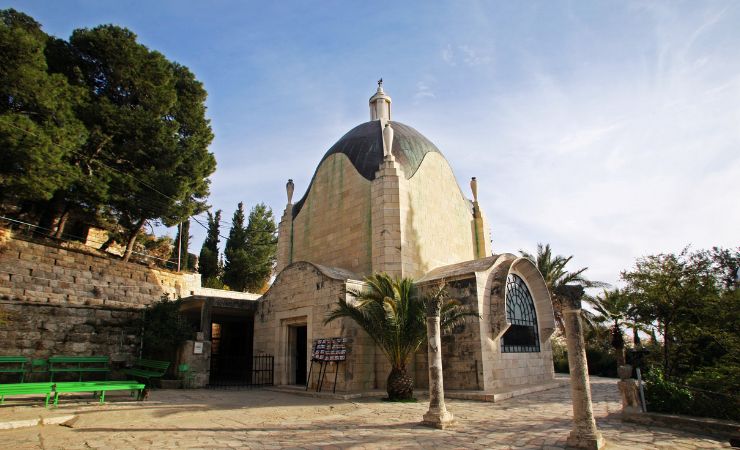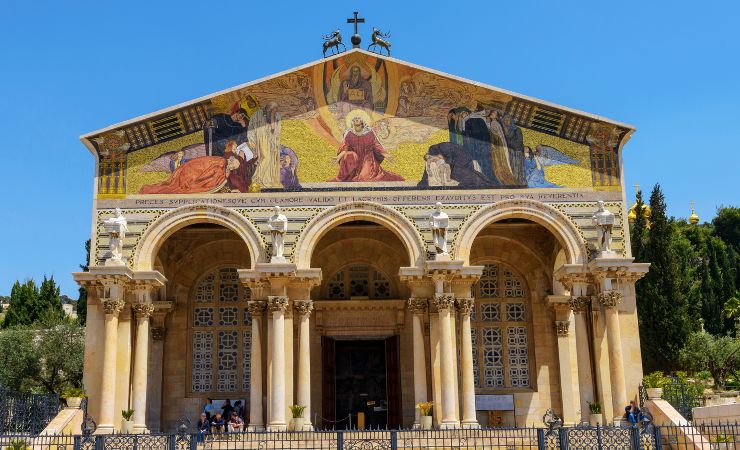Jerusalem’s YMCA: Amazing Architecture of Coexistence in Stone and Spirit
The Jerusalem International YMCA is a significant landmark, embodying a vision of unity and coexistence among diverse faiths.

Location
The YMCA is located at 26 King David Street, a short walk from the Old City’s Jaffa Gate and right on the seam between East and West Jerusalem.



The Young Men's Christian Association (YMCA) in Jerusalem
The Young Men’s Christian Association (YMCA) was established in London in 1844, aiming to foster the development of body, mind, and spirit. This mission resonated globally, leading to the establishment of branches worldwide. In Jerusalem, the YMCA began its operations in 1878, initially functioning from a modest room on Mamilla Street before relocating to a more spacious facility on Jaffa Road. The vision for a more prominent center was championed by Dr. Archibald C. Harte, the YMCA’s General Secretary during the British Mandate. He envisioned a facility that would serve as a beacon of peace and unity in a city marked by religious and cultural diversity.
The 1930s were a time of rising tension in Jerusalem. The city was under British rule, and national and religious tensions were intensifying between Jews, Muslims, and Christians. Dr. Harte saw an opportunity—not for another church or a political institution, but for a shared cultural and spiritual space.
With funding from international donors (including a significant contribution from the YMCA in the United States), the project broke ground in 1928. Harte commissioned Arthur Loomis Harmon, the American architect behind the Empire State Building, to design the structure. The building was completed in 1933, during the high tide of British influence in the city.
Architectural Design and Symbolism
Construction of the current YMCA building commenced in 1928 and concluded in 1933. The design was entrusted to Arthur Loomis Harmon, an American architect renowned for co-designing the Empire State Building. Harmon’s design for the YMCA is a harmonious blend of Byzantine, Romanesque, and Moorish architectural styles, reflecting the city’s multifaceted heritage.
The Jerusalem YMCA has historically served as a center for cultural, athletic, and social activities. It was the site of Jerusalem’s first indoor swimming pool and hosted various events that brought together individuals from different backgrounds, promoting a spirit of community and coexistence.
The building is replete with symbolic elements that underscore its commitment to interfaith harmony:
- The three prominent arches at the main entrance are widely interpreted as representing the three monotheistic religions—Judaism, Christianity, and Islam—extending a welcoming gesture to all visitors into a shared and inclusive space.
- The central tower, standing at an impressive 152 feet and comprising 12 floors, is imbued with symbolism related to both Jewish and Christian traditions, representing the 12 tribes of Israel and the 12 apostles. Architecturally, the tower’s transformation from a square base (symbolizing earth in Byzantine thought) to an octagon using squinches, which then supports a dome (representing heaven), reflects Byzantine religious beliefs.
- In the garden leading up to the building, twelve cypress trees are planted, each signifying the 12 tribes of Israel, the 12 disciples of Jesus, and the 12 followers of Mohammed, further emphasizing the theme of interfaith connection. This motif of the number twelve is repeated within the building, with 12 windows illuminating the domes and 12 stone arches rising above the balconies in the auditorium and gymnasium.
- Three significant inscriptions are engraved on the building’s façade, each a foundational declaration of faith from the three religions: “The Lord our God the Lord is One,” in Hebrew; “I am the way,” in Aramaic; and “There is no God but God,” in Arabic. These inscriptions are strategically placed to foster a sense of dialogue and mutual recognition between the faiths.
- The forty columns that define the courtyard hold dual symbolism, representing both the Children of Israel’s 40 years of wandering in the desert and the 40 days of the temptation of Jesus. The capitals of these columns are uniquely embellished with intricate carvings depicting the flora, fauna, and people of the land, reflecting the natural world and its inhabitants. Unlike classical Greek or Roman capitals, these Byzantine-inspired capitals are more ornate and varied.
- Above the main entrance, a striking bas-relief depicts a six-winged seraph, an image inspired by the vision of the prophet Isaiah (Isaiah 6:2). This motif resonates with both Jewish and Christian iconography.
• Inside the building, an interfaith chapel was thoughtfully designed to accommodate worshippers of all faiths. This neutral sacred space incorporates symbols from Judaism, Christianity, and Islam, reflecting the YMCA’s commitment to mutual respect and understanding. - Architectural details throughout the building further illustrate the eclectic blend of styles. Horseshoe arches are a distinct nod to Moorish architecture. Lancet (pointed) arches and internal rib-vaulted passageways and vaulted ceilings are characteristic elements of Gothic design. Above some arches, the use of alternating shades of Jerusalem stone may be inspired by the Mamluk architectural technique known as ablaq. The overall symmetrical plan and elevation of the building reflect classical influences. The domes of the gymnasium and concert hall, reminiscent of the Hagia Sophia, feature windows around their circumference and utilize pendentives to transition from a square base to an octagon that supports the dome, showcasing Byzantine architectural principles.
- The vestibule at the main entrance features a replica in mosaic of the Madaba Map, a historical map of the region, underscoring Jerusalem’s central significance.
The Multifaith Chapel
Inside the building, you’ll find a chapel that isn’t just for Christians. It was designed as a neutral, sacred space for people of any faith—or none—to reflect and pray. The space includes symbols from all three major monotheistic religions, including Arabic calligraphy, biblical verses, and universal motifs like olive branches and stars.
This interfaith ethos wasn’t an afterthought—it was at the very core of Harte’s vision for the building: a place where “body, mind, and spirit” could thrive across religious lines.
Additional Information
- 1844: George Williams founds the first YMCA in London, England.
- 1855: The World YMCA is founded to support the global YMCA movement.
- 1878: The YMCA begins operations in Jerusalem, initially in a bookstore by Jaffa Gate, later moving to a modest room on Mamilla Street, then a more spacious facility on Jaffa Road.
- 1909: The organization purchases a small building near Damascus Gate in Jerusalem.
- During WWI: The Jerusalem building is closed by Turkish authorities.
- After WWI: The British reopen the Jerusalem YMCA, providing services to soldiers and residents.
- 1918-1931: Dr. Archibald C. Harte serves as General Secretary of the Palestine YMCA, purchasing land at Shepherds’ Field in Bethlehem during this period.
- 1920: Dr. Archibald C. Harte becomes General Secretary of the Jerusalem YMCA. His vision inspires significant donations for a new complex.
- 1928: With donations from the United States and Manchester, England, a plot of land is purchased from the Greek Orthodox Patriarchate. The cornerstone for the new Jerusalem YMCA building is laid by Lord Plummer, the British High Commissioner for Palestine. Construction begins, designed by Arthur Loomis Harmon.
- 1933 (April 18): The new Jerusalem YMCA building is dedicated by British General Edmund Lord Allenby.
- 1978: The Jerusalem Foundation begins supporting physical improvement projects at the Jerusalem International YMCA, starting with support in honor of the institution’s 100th anniversary.
- 1993: The Jerusalem International YMCA is nominated for the Nobel Peace Prize for its efforts in promoting peace, unity, kinship, and the dignity of humankind.
- 2001: The Jerusalem Foundation renovates the YMCA’s 600-seat auditorium, transforming it into the Mary Nathaniel Golden Hall of Friendship.
Nearby Sites
- King David Hotel – Jerusalem’s most iconic hotel, full of historic charm and incredible city views.
- Mishkenot Sha’ananim & Yemin Moshe – A photogenic neighborhood with artists’ studios and views of the Old City walls.
- Mamilla Mall – A modern shopping street with restaurants, cafes, and art installations, blending old and new Jerusalem.
- Tower of David Museum – Inside the Old City’s ancient citadel, this museum explores Jerusalem’s multi-layered history.



